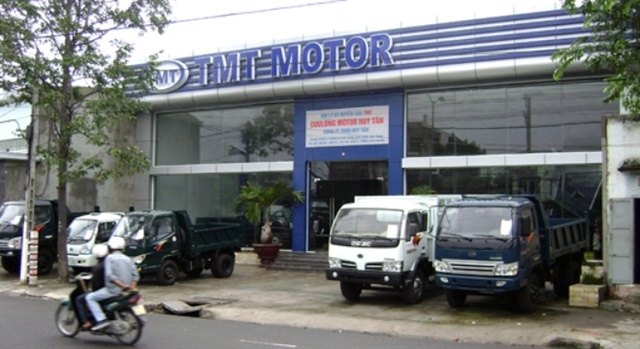 Economy
Economy

Automobile stocks are expected to lure more investment thanks to the growth of market consumption, forecast to reach over 500,000 vehicles per year from 2021.

|
| TMT closed Friday's trading at VNĐ5,800 (US$0.25) per share, down 37 per cent from the beginning of the year. Automobile stocks are expected to lure more investment thanks to the growth in consumption. — Photo cafef.vn |
HÀ NỘI — Automobile stocks are expected to lure more investment thanks to the growth of market consumption, forecast to reach over 500,000 vehicles per year from 2021.
On the stock market, shares of TMT Motors Corporation (TMT), a prominent importer and assembler in the capital city, closed Friday’s trading at VNĐ5,800 (US$0.25) per share, down 37 per cent from the beginning of the year. TMT has experienced a significant decline over the past four years.
TMT recorded an all-time peak of over VNĐ59,300 per share in October 2015, then plunged to its current value. The stock liquidity was also low, with only a few thousand units matched each session.
The slump of the TMT stock price is attributed to negative business results. In the first six months of 2019, TMT recorded revenue of VNĐ734 billion ($31.4 million), up 6.8 per cent.
However, the company suffered a loss of VNĐ5.9 billion due to higher costs of goods sold, up by VNĐ192 billion, equivalent to an increase of 120 per cent. Selling expenses rose by over VNĐ8 billion, equivalent to 106 per cent.
TMT also saw a loss of VNĐ10.6 billion in the same period of 2018.
With GGG stock of Giải Phóng Automotive Joint Stock Company, the situation is even worse.
Since early this year, GGG has witnessed few transactions, reaching only some 1,000 units per session, if any. The highest price that GGG achieved this year was VNĐ2,200 per share, in June.
GGG hit the daily limit decline of 7 per cent on Friday, closing at VNĐ1,200 per share.
GGG recorded a loss of VNĐ9.8 billion in 2018 and VNĐ7.2 billion in 2017.
Let alone the poor performers, automobile companies with positive business results have not received much attention from investors either.
For example, at the end of the first half of 2019, Trường Long Auto & Technology Joint Stock Company (HTL) reported a pre-tax profit of VNĐ18.1 billion, up by 11 times over the same period of 2018 thanks to an increase in consumption.
HTL shares lacked resilience, currently fluctuating around the threshold of VNĐ17,000-18,000 per share.
From the beginning of the year, HTL has recorded an increase of about 10 per cent. Liquidity remained very low, with the average matched the volume of 10 sessions being only some 1,000 shares per session.
Hàng Xanh Motors Service Joint Stock Company (HAX) closed Friday at VN19,450 per share, up 21.4 per cent compared to the beginning of the year.
However, the liquidity fluctuated and was generally low. The average matched volume in the most recent 10 sessions was about 24,000 shares per session.
In the first 6 months, HAX achieved VNĐ2.4 trillion in revenue, up 9.43 per cent over the same period of 2018. Pre-tax profit was VNĐ38.7 billion, down 16.8 per cent mainly due to increased competition.
In an interview with Đầu Tư Chứng Khoán (Securities Investment) newspaper, a representative of HAX said the number of distributed vehicles had risen sharply since the beginning of September and this is likely to continue until the end of this year, thereby helping the company improve sales and profits.
In a recent report, FPT Securities (FPTS) recommended that investors pay attention to HAX because its Mercedes’ sales would rise as the middle and upper classes in Việt Nam are increasing in size.
With the Việt Nam - EU Free Trade Agreement (EVFTA) coming into force, import taxes on cars and car parts from Europe will be reduced, making Mercedes’ prices more competitive.
HAX is also expanding the popular Nissan vehicle segment to diversify its products.
The auto market of Việt Nam boasts huge growth potential from now to 2025, according to the Industrial Policy and Strategy Institute (IPSI).
The institute forecast the consumption scale of Viet Nam’s automobile market is forecast to reach over 500,000 vehicles per year from 2021 onwards.
The domestic auto manufacturing industry will grow by about 18.5 per cent annually between 2018 and 2025 and 13.8 per cent between 2025 and 2035, raising the car output to nearly 531,600 units by 2025 and 1.76 million units in 2035.
With the growing middle class, car sales are set to respectively rise by 22.6 per cent each year from now to 2025 and 18.5 per cent in the following years.
Accordingly, Việt Nam’s population was estimated at over 96 million at the end of 2017. This figure is expected to rise to 98.2 million by 2020, 101.1 million by 2025 and 107.8 million by 2035.
Per capita GDP in the country was VNĐ53.5 million ($2,385) in 2017, which will increase by 6.8 per cent annually to $7,780 by 2035. More than half of the Vietnamese population will enter the global middle class by 2035 with the average daily spending of at least $15.
Expecting huge potential in the automobile market, many firms have moved into this field, such as local Vingroup with the recent launch of automobile brand Vinfast.
Phú Nhuận Service JSC (Maseco) has also participated in the automotive business after exiting the Ariang electronic product distribution channel. — VNS




